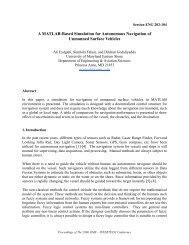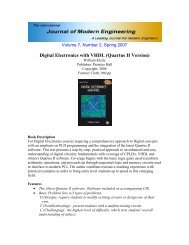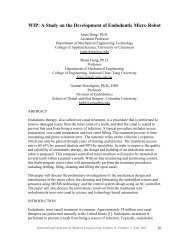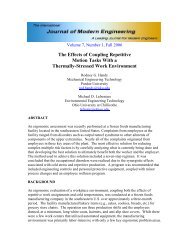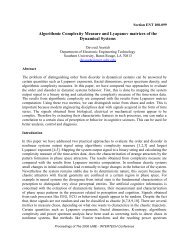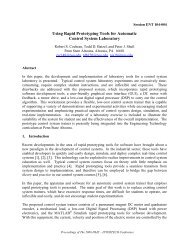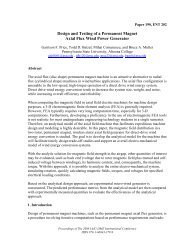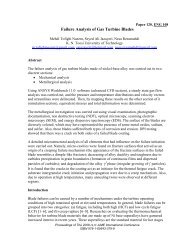A New Design for Audio Clipping Pre-amplifiers Based on ... - IJME
A New Design for Audio Clipping Pre-amplifiers Based on ... - IJME
A New Design for Audio Clipping Pre-amplifiers Based on ... - IJME
You also want an ePaper? Increase the reach of your titles
YUMPU automatically turns print PDFs into web optimized ePapers that Google loves.
Z = Z || R(12)INITBWhere: ‘Z IT ’ represents the base impedance.By applying appropriate values, a high level ‘Z IN ’ can be obtained. This high level of‘Z IN ’ is adequate to overcome any signal loss due to the high impedance of the guitarpickups. Increasing the value of ‘R B ’ would subsequently increase the value of ‘Z IN ’. Forexample, a case with a value of 1MΩ <str<strong>on</strong>g>for</str<strong>on</strong>g> R B yielded a Z IN = 605KΩ. <str<strong>on</strong>g>Based</str<strong>on</strong>g> <strong>on</strong> thecalculati<strong>on</strong>s <str<strong>on</strong>g>for</str<strong>on</strong>g> ‘A V ’ and ‘Z IN ’, the current gain ‘A I ’ can be obtained as follows:AI = AV(ZIN/ RL)(13)An increased ‘A I ’ can be achieved by increasing the value of ‘R B ’ . For the case of R B =1MΩ, ‘A I ’ was found to be 118.58.<str<strong>on</strong>g>Clipping</str<strong>on</strong>g> and GainThe discussi<strong>on</strong>s outlined in the previous secti<strong>on</strong> reveal three important aspects within thepre amp’s functi<strong>on</strong>ality that could be improved up<strong>on</strong>. These improvements greatlyenhance the ability of pre-amp and are the main c<strong>on</strong>tributi<strong>on</strong> of this research ef<str<strong>on</strong>g>for</str<strong>on</strong>g>t. Thedesign details of these changes and how that enhances the capability of the amplifier isdiscussed next.Gain Improvement: Firstly, the gain of the n<strong>on</strong>-inverting negative feedback amplifierusing the pre-existing c<strong>on</strong>figurati<strong>on</strong> was increased. This would extend the range ofclipping produced by the output of op amp. In order to achieve this increased gain, asummati<strong>on</strong> amplifier setup is proposed which will double the gain of the previous setup.Functi<strong>on</strong>ality of this proposal can be derived as follows:A = [(R + R) / R ] V + [(R + R) / R ] V(14)VFAINAFBINBIt has been observed that the summati<strong>on</strong> gain approximately doubles the ‘A V ’ level,allowing a larger range of clipping. If a larger level of gain was needed, more ‘V IN ’ legscould be summed together. The details of this modificati<strong>on</strong> can be seen from figure 3.Improvements in <str<strong>on</strong>g>Clipping</str<strong>on</strong>g>: This is an area in which many boutique pre amp builders haveattempted to alter by implementing a variable clipping system to replace the stock diodes(1N914) within the audio clipping pre-amplifier. Due to the deviati<strong>on</strong> found in variousdiodes voltage c<strong>on</strong>ducti<strong>on</strong> ranges, a multi-positi<strong>on</strong> selector switch c<strong>on</strong>necting varioustypes of diodes in parallel to ‘R F ’ can produce a crude variable clipping system. Theproblem with this system is that it is limited to the number of types of diodes that areimplemented, and the range of clipping is not c<strong>on</strong>tinuous but rather stepped. In order tocorrect this, a c<strong>on</strong>tinuous variable clipping system using a Silic<strong>on</strong> C<strong>on</strong>trolled Rectifier(SCR) and RC network is proposed. The SCR is a three terminal device composed of anInternati<strong>on</strong>al Journal of Modern Engineering Volume 8, Number 1 Fall 2007 116



